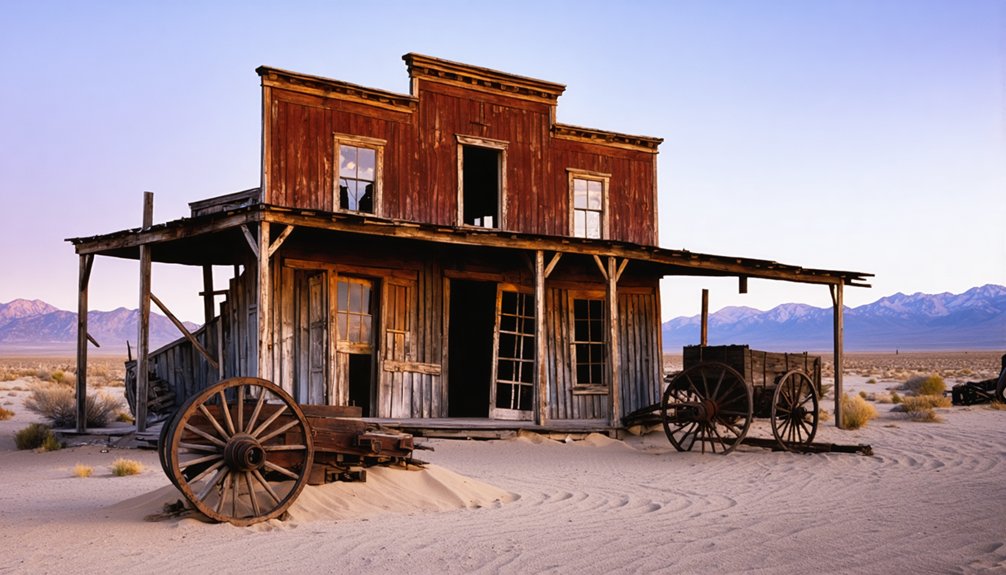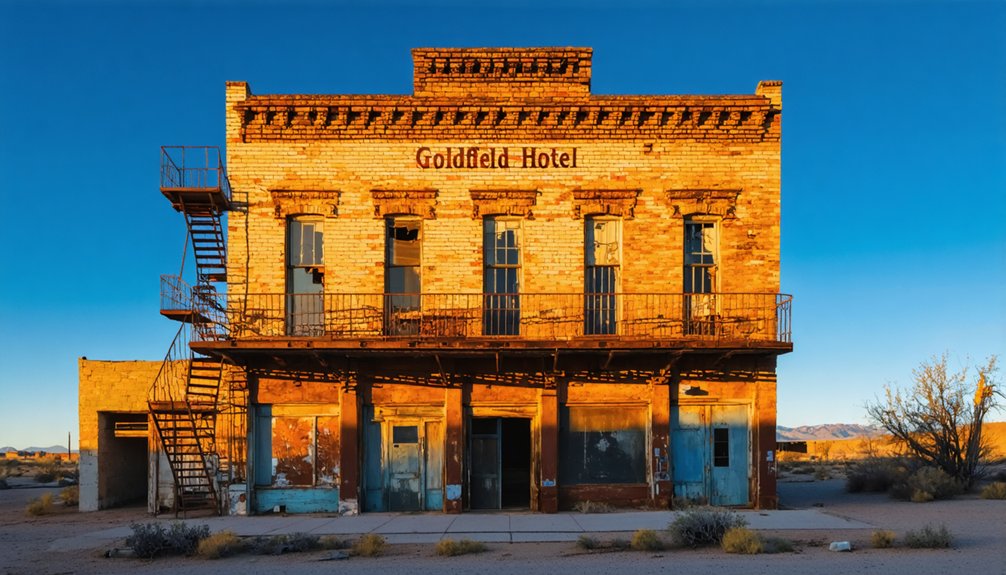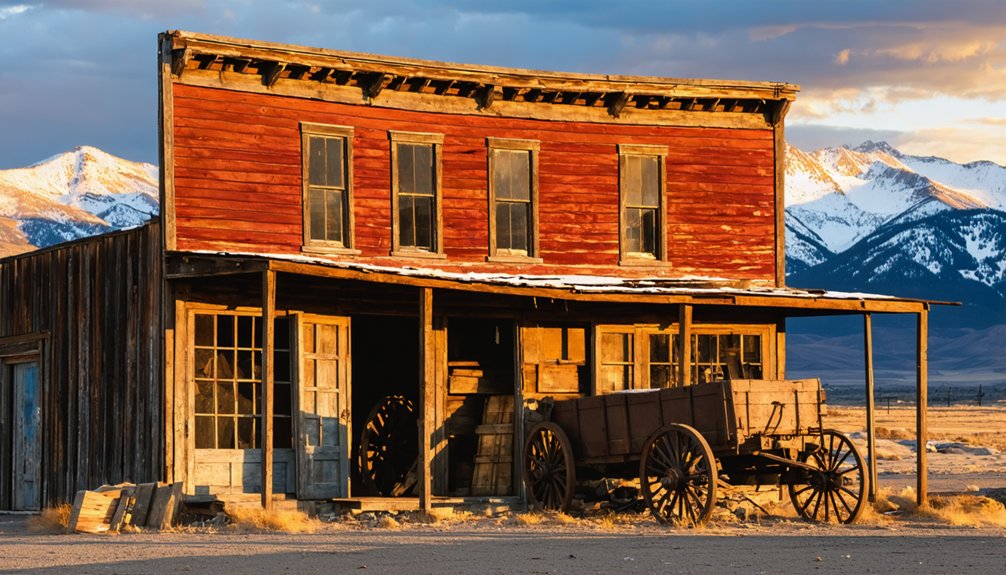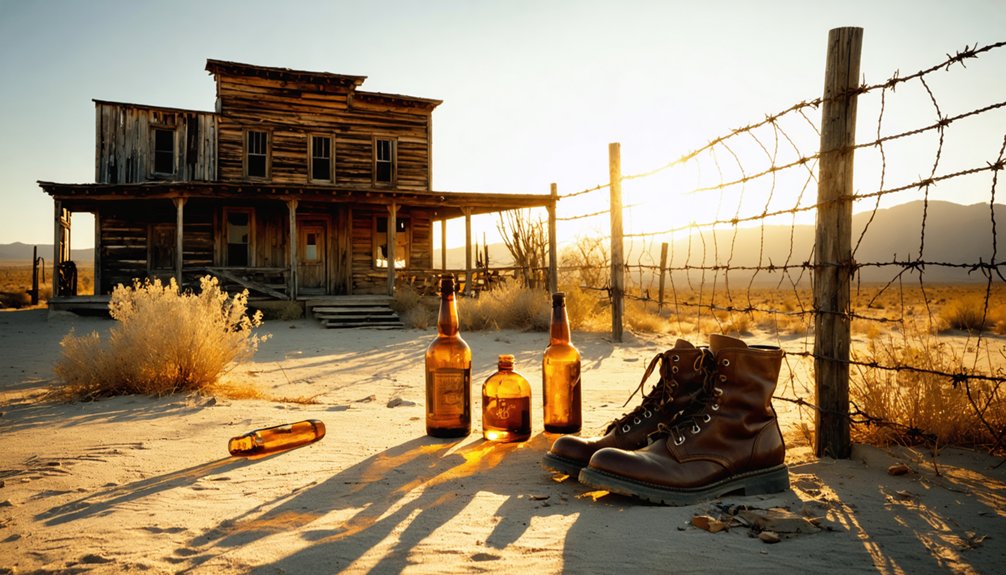Nevada boasts over 600 ghost towns scattered across its desert landscape, offering you tangible connections to the Wild West era. From Rhyolite’s iconic Bottle House to Goldfield’s grand buildings and Belmont’s 150-year-old courthouse, each abandoned settlement tells unique boom-and-bust stories. Prepare with reliable maps, a 4WD vehicle, and emergency supplies when visiting these remote historical treasures. The silent wooden structures and mining remnants await your exploration into Nevada’s fascinating frontier past.
Key Takeaways
- Nevada has over 600 ghost towns to explore, with Rhyolite, Goldfield, Belmont, and Jarbidge being notable destinations with unique histories.
- Use reliable maps like the Nevada Ghost Towns interactive map or NBMG Ghost Town Atlas to locate remote sites.
- Prepare for remote desert exploration with 4WD vehicles, offline maps, plenty of water, and emergency supplies.
- Respect preservation efforts by photographing rather than removing artifacts from these public BLM lands.
- Visit architectural treasures like Rhyolite’s Bottle House or Belmont’s 1876 courthouse to experience Nevada’s mining heritage.
The Rich History Behind Nevada’s 600+ Abandoned Settlements

When you travel across Nevada’s rugged landscape today, you’re witnessing the aftermath of one of America’s most dramatic boom-and-bust cycles. Over 600 ghost towns scatter the state, silent monuments to the mining heritage that shaped Nevada’s identity after gold was discovered near Dayton in 1849.
While most settlements emerged from mining operations following the Comstock Lode and subsequent strikes, some like Metropolis were planned agricultural communities. These towns flourished briefly—Goldfield swelled to 20,000 residents by 1906, while Belmont hosted thousands during its silver boom from 1865 to the 1890s. Visitors can explore these sites to gain a glimpse into Nevada’s fascinating past.
Their cultural significance extends beyond abandoned structures; they’re tangible links to the Wild West era, showcasing how quickly fortunes turned when ore deposits vanished or natural disasters struck, leaving behind only stone ruins and powerful stories. Many ghost towns like Aurora and Delamar suffered significant population decline due to devastating fires and economic challenges that ultimately led to their abandonment.
Exploring Rhyolite: The Photogenic Mining Town Frozen in Time
When you visit Rhyolite’s historic Bottle House, you’ll encounter a remarkable preservation effort initiated by Paramount Pictures’ parent company in 1925 for the silent film “The Air Mail.”
The iconic John S. Cook Bank Building stands as Nevada’s most photographed ghost town structure, its three-story walls capturing the imagination of photographers and history enthusiasts alike.
These photogenic ruins offer exceptional opportunities to document the dramatic rise and fall of a mining boomtown that flourished and collapsed within a single decade. The discovery by Shorty Harris and Cross in 1904 triggered Nevada’s recovery from a thirty-year depression, transforming empty desert into a bustling city almost overnight.
Today, visitors can still see the remnants of what was once a thriving metropolis with over 400 electric streetlights illuminating its streets during the town’s heyday.
Bottle House Legacy
Among Rhyolite’s many fascinating remnants, the iconic Bottle House stands as perhaps the most ingenious example of frontier resourcefulness and architectural adaptation.
Built by Tom Kelly in 1905-1906 using approximately 50,000 bottles from local saloons, this three-room structure showcases remarkable bottle architecture that provided natural insulation and light.
When you visit, you’ll notice bottles mortared with their bottoms facing outward, preserving their original contents within. The double bottle foundation created excellent thermal insulation, helping residents endure Nevada’s extreme desert temperatures.
The house changed hands several times—from the raffle-winning Bennet family to Paramount Pictures, which restored it for Western films in 1925.
Significant preservation challenges stem from the adobe mortar’s fragility and vulnerability to heat and earthquakes. The house became a museum after filming was completed, allowing visitors to witness this unique frontier architecture.
Despite these obstacles, restoration efforts, including the 2005 roof replacement, have maintained this exceptional landmark’s integrity, allowing you to experience a truly innovative response to the frontier’s material scarcity.
Desert Ruins Photography
Why has Rhyolite earned its reputation as the most photographed ghost town in the American West? Its enduring stone and concrete structures offer a rare glimpse into mining-era architecture, perfectly preserved against the Mojave Desert backdrop.
The iconic Cook Bank Building—Nevada’s most photographed ghost town structure—stands as a testament to the town’s brief opulence.
Visit at sunrise or sunset when desert light casts golden hues across structural textures, highlighting the unique qualities of the railroad depot and Broadway Street foundations.
Winter provides crisp, haze-free conditions for landscape photography, while night shoots capture the Milky Way above these century-old ruins.
The nearby Goldwell Open Air Museum adds artistic foreground elements to your compositions, with sculptures dramatically framed by the Bullfrog Hills. During its peak period, Rhyolite’s impressive community featured 50 saloons and numerous other establishments that reflected its rapid growth.
The town reached its zenith between 1907-1908 with a population of 5,000, before mining difficulties triggered its eventual abandonment.
Goldfield’s Grand Structures: From Boom to Near Abandonment

Goldfield’s transformation from a remote desert location to Nevada’s largest city represents one of the West’s most dramatic boom-to-bust stories.
When you visit today, you’ll find the skeletal remains of grand commercial architecture that once rivaled major Nevada cities.
At its 1906 peak, Goldfield boasted 30,000 residents, 49 saloons, and 22 hotels—a reflection of the mining legacy that produced over $86 million in ore.
You’ll be walking the same streets that hosted a championship boxing match that captured national attention.
The arrival of the Tonopah and Goldfield Railroad in September 1905 significantly accelerated the town’s development and prosperity.
The Goldfield Consolidated Mining Company formed in 1906 through crucial mergers that centralized operations and boosted productivity.
The town’s decline came swiftly.
After labor disputes brought federal troops in 1907 and consolidation transformed operations, a devastating 1913 flood and catastrophic 1923 fire destroyed most structures.
Belmont: The Silver Outpost That Defied Desert Time
While Goldfield dazzled visitors with its grand urban aspirations, Belmont presents a more intimate glimpse into Nevada’s mining history through its remarkably preserved structures.
Established after an 1865 silver strike, this former Nye County seat reached 2,000 residents during its 1870s heyday, generating approximately $15 million in ore throughout its operational lifetime.
The silver rush transformed Belmont from desert outpost to thriving county seat, yielding riches that echo through its historic streets.
You’ll find the crown jewel of Belmont architecture in the 1876 Nye County Courthouse, whose craftsmanship has withstood 150+ years of desert elements.
As you explore the town’s mining legacy, you’ll discover why it earned National Register of Historic Places designation in 1972.
Self-guided walking tours allow you to examine miner cabins, the Monitor-Belmont Mill’s bullet-riddled chimney, and numerous commercial buildings that once supported this thriving silver outpost.
Jarbidge: Nevada’s Final Gold Rush Frontier

As dawn broke over northeastern Nevada in 1909, prospector David Bourne’s gold discovery near Jarbidge triggered what historians recognize as one of the American West’s final significant gold rushes.
By 1910, wooden structures replaced canvas tents while the population swelled to nearly 2,000 during peak periods.
Jarbidge Mining operations transformed from simple panning to sophisticated underground extraction when Elkoro Mining Company introduced electric milling in 1918.
When visiting this remote historical frontier, you’ll discover:
- The site of America’s last stagecoach robbery (1916)
- Remains of a town that produced over 200,000 ounces of gold (valued at $336 million today)
- Historical buildings that survived the devastating 1919 fire and harsh alpine conditions at 6,200 feet elevation
Planning Your Ghost Town Adventure: Maps, Access and Preservation
Before starting your Nevada ghost town expedition, proper preparation with reliable maps and research materials proves essential for discovering these hidden historical treasures.
The Nevada Ghost Towns interactive map covers 800+ sites, while the NBMG Ghost Town Atlas features 725 locations across 71 color maps—critical tools for effective ghost town mapping.
Be prepared for access challenges in remote desert locations where cell service vanishes and unmarked sites require GPS coordinates rather than standard directions.
Many locations demand 4WD vehicles, particularly in Northern and Eastern Nevada. Always travel with offline maps, water, and emergency supplies.
Most sites exist on public BLM land with varying preservation states—from Belmont’s standing structures to sites with mere foundations.
Remember that removing artifacts is illegal; photograph these historical remnants instead.
Frequently Asked Questions
Are Ghost Towns Legally Accessible or Considered Trespassing?
Like walking a legal tightrope, ghost towns’ accessibility depends entirely on property rights. Public sites welcome visitors, but entering privately owned locations without permission violates legal restrictions and constitutes criminal trespassing.
What Paranormal Activity Has Been Documented in Nevada Ghost Towns?
You’ll encounter numerous documented ghost sightings across Nevada’s ghost towns, including spectral figures in Rhyolite, haunted locations like Goldfield Hotel, and persistent paranormal activity in Virginia City’s historic buildings.
Can Visitors Collect Artifacts or Souvenirs From Ghost Towns?
While freedom calls, artifact preservation demands restraint. You can’t legally collect artifacts from ghost towns without permits. Photography remains your ethical souvenir option, respecting both history and law.
How Dangerous Are Structural Hazards and Wildlife Encounters?
Structural hazards pose extreme dangers, with documented deaths and injuries from mine collapses. Wildlife encounters require vigilance too. Always prioritize structural integrity assessments and wildlife safety when exploring these unregulated historical sites.
Which Ghost Towns Allow Overnight Camping or Accommodation?
Like travelers who discovered Goldfield’s hidden charms, you’ll find Berlin-Ichthyosaur State Park offers formal campsites with regulated 14-day stays, while Delamar allows dispersed camping on BLM land under standard camping regulations.
References
- https://en.wikipedia.org/wiki/List_of_ghost_towns_in_Nevada
- https://www.visittheusa.com/experience/6-nevada-ghost-towns-explore-if-you-dare
- https://www.atlasobscura.com/things-to-do/nevada/ghost-towns
- https://nvtami.com/nevada-ghost-towns-map/
- https://www.smithsonianmag.com/sponsored/nevadas-living-and-abandoned-ghost-towns-180983342/
- https://travelnevada.com/ghost-town/
- https://nvtami.com
- https://forgottennevada.org/sites/newlist.html
- https://www.ghosttowns.com/states/nv/nv.html
- https://www.youtube.com/watch?v=kg18CwWeMnc



